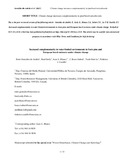Increased complementarity in water-limited environments in Scots pine and European beech mixtures under climate change
Fecha
2017Autor
Versión
Acceso abierto / Sarbide irekia
Tipo
Artículo / Artikulua
Versión
Versión aceptada / Onetsi den bertsioa
Impacto
|
|
10.1002/eco.1810
Resumen
Management of mixedwoods is advocated as an effective adaptation strategy to increase ecosystem
resiliency in the context of climate change. While mixedwoods have been shown to have greater resource
use efficiency relative to pure stands, considerable uncertainty remains with respect to the underlying
ecological processes. We explored species interactions in Scots pine / European beech mixe ...
[++]
Management of mixedwoods is advocated as an effective adaptation strategy to increase ecosystem
resiliency in the context of climate change. While mixedwoods have been shown to have greater resource
use efficiency relative to pure stands, considerable uncertainty remains with respect to the underlying
ecological processes. We explored species interactions in Scots pine / European beech mixedwoods with
the process-based model FORECAST Climate. The model was calibrated for two contrasting forests in
the southwestern Pyrenees (northern Spain): a wet Mediterranean site at 625 m.a.s.l. and a subalpine site
at 1335 m.a.s.l. Predicted mixedwood yield was higher than that for beech stands but lower than pine
stands. When simulating climate change, mixedwood yield was reduced at the Mediterranean site (-33%)
but increased at the subalpine site (+11%). Interaction effects were enhanced as stands developed.
Complementarity dominated the Mediterranean stand but neutral or net competition dominated the
subalpine stand, which had higher stand density and water availability. Reduced water demand and
consumption, increased canopy interception, and improved water-use efficiency in mixtures compared to
beech stands suggest a release of beech intra-specific competition. Beech also facilitated pine growth
through better litter quality, non-symbiotic nitrogen fixation and above- and belowground stratification,
leading to higher foliar nitrogen content and deeper canopies in pines. In conclusion, mixtures may
improve water availability and use efficiency for beech and light interception for pine, the main limiting
factors for each species, respectively. Encouraging pine-beech mixtures could be an effective adaptation
to climate change in drought-prone sites in the Mediterranean region. [--]
Materias
Species complementarity,
Mixedwoods,
Ecological modelling,
Pinus sylvestris,
Fagus sylvatica,
Interspecific competition,
Intraspecific competition
Editor
Wiley
Publicado en
Ecohydrology 10(2): e1810
Departamento
Universidad Pública de Navarra. Departamento de Ciencias del Medio Natural /
Nafarroako Unibertsitate Publikoa. Natura Ingurunearen Zientziak Saila
Versión del editor
Entidades Financiadoras
Ramón y Cajal contract, Grant/Award Number:RYC‐2011‐08082; Spanish Ministry of Economy and Competitiveness, Grant/AwardNumber: AGL2012‐33465; mobility aid,Grant/Award Number: EEBB‐I‐15‐09220; Spanish Predoctoral Research Grant, Grant/Award Number: BES‐2013‐066705.






